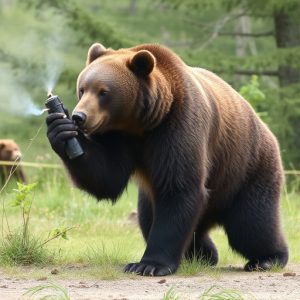Bear Repellent Spray: Effectiveness, Usage Tips, and Understanding Bears
Bears have an incredible sense of smell, making scent a critical factor in their behavior and surviv…….
Bears have an incredible sense of smell, making scent a critical factor in their behavior and survival. Bear spray, while effective in deterring attacks, varies in impact based on usage and environmental conditions. Proper application, including direct spraying into a bear's face at close range, is essential for success. Scientific research supports capsaicin-based sprays, but understanding limitations like weather, distance, and bear behavior is crucial. Optimal effectiveness requires following best practices: using EPA-registered sprays with at least 15% capsaicin, testing beforehand, applying liberally from 20-25 feet, staying alert, making noise, and carrying backup supplies.
“Exploring the Great Outdoors should be an exhilarating adventure, free from fear. Yet, hiking in bear country comes with inherent risks. This article guides you through the essential tool for safety: bear repellent spray. We demystify its effectiveness by delving into bear behavior and the science behind the spray’s power. Learn the best practices for application to ensure maximum protection during your hikes. With extensive research on active ingredients, discover why and when this repellent is a hiking necessity.”
- Understanding Bear Behavior and Their Sense of Smell
- The Science Behind Bear Spray: Active Ingredients and Effectiveness
- Best Practices for Using Bear Repellent Spray While Hiking
Understanding Bear Behavior and Their Sense of Smell
Bears, especially grizzly bears, have an incredible sense of smell, up to 200 times more sensitive than humans’. This keen odor detection is a key aspect of their survival and behavior. They use scent to locate food, communicate with other bears, and assess potential threats or partners. Understanding this behavioral trait is crucial when hiking in bear country.
Research on bear spray effectiveness has shown mixed results. While some studies suggest that bear spray can deter attacks, others claim its impact is minimal. The key lies in proper usage; spraying directly into the bear’s face at close range is most effective. Bear spray creates an irritant barrier, temporarily disorienting the bear and giving you time to escape. However, it’s essential to remember that no single measure guarantees complete protection against bear encounters, and knowing how to react during such situations is equally vital.
The Science Behind Bear Spray: Active Ingredients and Effectiveness
The Science Behind Bear Spray: Active Ingredients and Effectiveness
Bear spray, also known as bear repellent spray, has become a hiking necessity for adventurers navigating areas inhabited by bears. Its effectiveness stems from a combination of carefully selected active ingredients designed to deter aggressive behavior in bears. The key components often include capsaicin, the active compound found in chili peppers, and various other irritants that trigger a strong reaction when sprayed directly onto an animal’s face. Research on bear spray effectiveness has shown promising results, with studies indicating that proper use can significantly reduce the risk of bear attacks.
How Effective Is Bear Spray? Scientific research supports the efficacy of bear spray as a defensive tool. Tests have demonstrated that when sprayed accurately and within close range, bear spray can create a protective barrier, causing bears to avoid or retreat. However, it’s crucial for users to understand the spray’s limitations and proper application techniques. Not all bear spray formulations are created equal, and factors like weather conditions, distance, and the bear’s behavior can influence its effectiveness. Therefore, hikers should always choose reputable brands and familiarize themselves with the product’s specifications before venturing into bear country.
Best Practices for Using Bear Repellent Spray While Hiking
When using bear repellent spray while hiking, it’s crucial to follow best practices for optimal effectiveness. Begin by ensuring your spray is EPA-registered and contains a minimum of 15% capsaicin, the active ingredient that deters bears. Always test the spray in a controlled environment before embarking on your hike; read the instructions thoroughly and understand the range, wind conditions, and safety precautions recommended by the manufacturer.
For maximum protection, apply the spray liberally when encountering bears or potential bear activity. Spray directly towards the bear’s face from a safe distance of 20-25 feet (6-7 meters). Keep in mind that how effective bear spray is can vary based on research; studies show it can reduce bear attacks by up to 92% when used correctly. Remember, while bear spray is a valuable tool, it’s not foolproof—always stay alert, make noise to deter bears, and carry other repellents or emergency supplies as backup.
Bear repellent spray is a crucial addition to any hiker’s essential kit, as evidenced by extensive research on bear behavior and the science behind these repellents. Understanding how bears perceive scent and the active ingredients in bear spray reveals its effectiveness as a safety measure. By following best practices for application, hikers can significantly reduce the risk of bear encounters and ensure a more enjoyable outdoor experience. Remember, knowledge is power, and being prepared with quality bear repellent spray is a game-changer for any adventure in bear country.

